|
 This page is written monthly by Harumi Okochi, and sometimes Harumi's friends join. We'd be happy if you look at our previous issues. #1 GREETING |
#27 June, 2002 |
||||
|
 This page is written monthly by Harumi Okochi, and sometimes Harumi's friends join. We'd be happy if you look at our previous issues. #1 GREETING |
#27 June, 2002 |
||||
Dear Readers, I would like you to meet my friend Diane Hall Sugg. Once you meet her, you will surely fall in LOVE with her. She is such a cheerful, thoughtful lady, making other people happy. |
|||||||||||
Dear Harumi-san, Thank you for asking me to share my impressions of Japan with your readers. There are many intriguing places in this world that invite us to explore, but with Japan there is even more. Japan causes me to wonder about many things, and calls me to return. DHS IMPRESSIONS OF JAPAN Written by Diane Hall Sugg |
|||||||||||
|
Hello, my name is Diane and I live in Virginia Beach, Virginia, USA. Japan is on the other side of the world from our home, a 14-hour time difference, in fact. My husband and I planned for over a year as to how we could see this fascinating country in just three weeks. For Tom, this would be a "nostalgia tour". He hoped to observe the changes that had taken place since his Navy days 35 years ago, and to reunite with Japanese friends. Little did he know how astounding those changes would be. As for me, my connection with Japan began as a teenager, through books, museum visits, and even the movies. This would be my first trip to a country whose art and culture I longed to experience first hand. 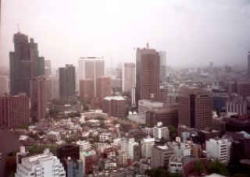 FIRST IMPRESSIONS Long flights tend to confuse the mind, but
changes in time were not important to us,
as we were too excited! Entering Japan at
Narita International Airport is efficient
and orderly. Everyone is courteous and willing
to help. Tom is happy to report that "this
is the Japanese way" that he remembered
so well. Later, looking out our Tokyo hotel
room window, as far as the eye could see,
were high-rise buildings reaching for the
sky. FIRST IMPRESSIONS Long flights tend to confuse the mind, but
changes in time were not important to us,
as we were too excited! Entering Japan at
Narita International Airport is efficient
and orderly. Everyone is courteous and willing
to help. Tom is happy to report that "this
is the Japanese way" that he remembered
so well. Later, looking out our Tokyo hotel
room window, as far as the eye could see,
were high-rise buildings reaching for the
sky. Tokyo, with its 12 million inhabitants, seemed endless. The streets were filled with small sized cars, while countless numbers of people poured out of subways and filled the sidewalks. Cherry blossoms and azaleas were in bloom, adding color to the landscape. This was a city of energy and purpose and we went out to meet it. Museums are a good place to begin learning about a country, and one of our favorites turned out to be Tokyo's National Museum of Japan. A veritable feast for the eyes, we lingered over each exhibit, trying to absorb some of Japan's history and culture. 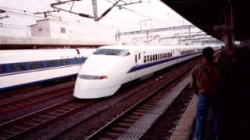 GETTING AROUND Everywhere we went there were people willing
to help confused tourists! Kanji signs were
both exotic and bewildering, but unlike 35
years ago many signs were also printed in
English, enabling us to find our way with
greater confidence. Every mode of transportation
was amazingly on time, as well as clean and
comfortable, making travel a pleasure. GETTING AROUND Everywhere we went there were people willing
to help confused tourists! Kanji signs were
both exotic and bewildering, but unlike 35
years ago many signs were also printed in
English, enabling us to find our way with
greater confidence. Every mode of transportation
was amazingly on time, as well as clean and
comfortable, making travel a pleasure. A welcome surprise was the "no smoking" rule for transportation systems, as well as the availability of smoke free hotel rooms, and smoke free sections in many restaurants. Initially, Tom and I joined a Japan Travel Bureau (JTB) tour, which is a great way to see Japan if time is limited. JTB is a first class tour operator. Our guides were knowledgeable and attentive, and we were a happy group. From Tokyo to Osaka with Fuji, Hakone, Nagoya, Toba, Ise, Kyoto, Nara, Hiroshima, Kurashiki, and many wonderful points of interest in between, the ancient castles, shrines and temples continually awed Tom and me. We were surprised to learn that some of the Shinto Shrine structures were actually taken apart and rebuilt every 20 years or so. Thus, what is old is constantly being renewed. Most memorable were the sights where history seemed to come alive. Nijo Castle, in Kyoto, with its unique 'Nightingale floors' still squeaks a warning of possible danger with each step. Public rooms were graced with magnificent sliding door panels, painted in the Kano School style, while in the halls we saw ornate woodcarvings and painted ceilings. One could imagine the formal ceremonies and palace intrigue, while somewhere behind the scene were guards, servants, and family who lived out their lives. If only walls could talk! At the most sacred Shinto Shrine in all Japan, the Ise-Jingu Shrine, one does not have to imagine what life was like. This beautiful structure continues to attract the faithful. It's imposing size, and magnificent architecture somehow dwarfs the crowd of visitors. Even the ancient cedars are giant sized, and appear to watch over worshipers as they follow ancient rituals. The Ohara house in Kurashiki was home to the first Japanese merchant elevated to Samurai status. This unusually large home still holds family possessions, including every convenience available at that time. It is easy to imagine the daily life of this privileged family. 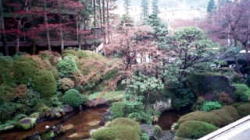 The parks in Japan simply took
our breath away. Trees and flowers set the
scene, while the artful placement of rock
and stone and the graceful swirl of sand
added texture. The element of water created
tranquility with sound and movement, inviting
us to stay. The parks in Japan simply took
our breath away. Trees and flowers set the
scene, while the artful placement of rock
and stone and the graceful swirl of sand
added texture. The element of water created
tranquility with sound and movement, inviting
us to stay. At the park adjacent to the Imperial Residence in Tokyo, we watched gardeners, using three-legged ladders, carefully tending ancient Bonsai trees. Some actually plucked pine needles from their branches one needle at a time to create the desired appearance. Later, we learned that the gardeners in this park were dedicated to the care of just one tree! Truly, we had witnessed the spiritual bond that exists between man and nature in Japan. 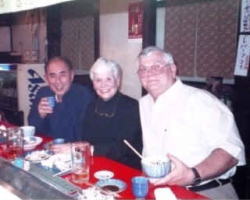 Another way to learn about a country
is by tasting their food. The results can
be delicious, interesting, or downright scary
for an outsider! Still, Tom and I were eager
to explore authentic Japanese cooking. Tempura,
Sukiyaki, Shabu-Shabu, Sushi, dishes with
sweet curry, thinly sliced ginger, garlic
chips, Daikon radishes and green tea are
easy to love. Though I tried it all, and
discovered there was much to enjoy, a steady
diet of pickles for breakfast and raw fish
were a bit strange for this westerner's palate.
In contrast, we were surprised to discover
bakeries and restaurants offering the most
tempting breads and desserts. Another way to learn about a country
is by tasting their food. The results can
be delicious, interesting, or downright scary
for an outsider! Still, Tom and I were eager
to explore authentic Japanese cooking. Tempura,
Sukiyaki, Shabu-Shabu, Sushi, dishes with
sweet curry, thinly sliced ginger, garlic
chips, Daikon radishes and green tea are
easy to love. Though I tried it all, and
discovered there was much to enjoy, a steady
diet of pickles for breakfast and raw fish
were a bit strange for this westerner's palate.
In contrast, we were surprised to discover
bakeries and restaurants offering the most
tempting breads and desserts.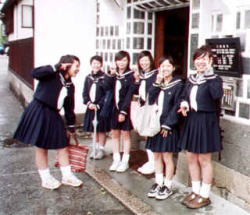 CONTRASTS Observing everyday life in Japan is a study in contrasts, adding another dimension to my Japanese education. There were early morning street sweepers, office workers at their exercise, and bright-faced students in uniforms of blue. We watched potters at their wheels; vendor's opening their shops, fishermen in their boats, and women hanging their clothes out to dry. (By the way, we learned that weather reports generally include a laundry forecast!) Most foreigners, especially me, struggle to use Hashi, while Japanese occasionally dine with knives and forks. Also, we saw tiny, old shops that squat beside the latest in modern architecture. By night, flashing neon lights compete for our attention, while daytime finds us watching an ancient Noh play on an outdoor stage. At every turn we saw the latest in technology blending with ancient tradition, as when we came upon two wedding parties being filmed with the latest in Video Cameras. The first couple had adopted formal western style wedding clothing, while the second kept to traditional formal Japanese wedding attire. Still, it seems that both couples had trusted in ancient ways of finding an auspicious day for their weddings. PLEASURES OF RYOKAN YOYOKAKU Our JTB tour came to an end in Osaka. Eager to see our friends and immerse ourselves in Japanese life, we hastened to Ryokan Yoyokaku (Japanese Inn) in 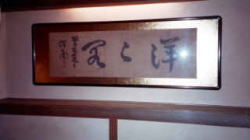 Karatsu on the island of Kyushu. After
a short plane journey from Osaka to Fukuoka,
we boarded a train at the airport for the
short 2-hour ride to Karatsu. A taxi delivered
us to the entrance of Ryokan Yoyokaku with
its stone walk washed in welcome. As we entered
we paused at the Tokanoma to admire the magnificent
calligraphy and graceful floral arrangement. Karatsu on the island of Kyushu. After
a short plane journey from Osaka to Fukuoka,
we boarded a train at the airport for the
short 2-hour ride to Karatsu. A taxi delivered
us to the entrance of Ryokan Yoyokaku with
its stone walk washed in welcome. As we entered
we paused at the Tokanoma to admire the magnificent
calligraphy and graceful floral arrangement.Our friends and hosts, Harumi and Den Okochi, are waiting to greet us. Harumi-san and Den-san welcome us into another world-----the tranquil and hospitable world of Ryokan Yoyokaku. But wait….."Diane-san, do not forget to exchange your street shoes for slippers"! Yoyokaku provides the perfect escape, and we are ready. Tom and I are guided to our room, which is beautiful in it's simplicity. Later, we stroll the garden wearing traditional Yukata's and admire the ancient pines. (Some are 200 years old.) 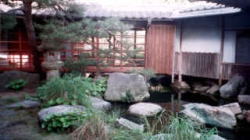 A sense of peace descends on us in this tranquil setting. It was our Anniversary and the Okochi's honored us with their company. We dine on Shabu -Shabu and many other delicacies. The personal touches, including a cake with candles, make this an evening we will long remember. Later, my first experience with a Japanese bath and Futons for bedding, meet with immediate approval. Today, Harumi-san has arranged for her friends, Suzue-san and Hiroshi-san, who are volunteer tourist guides, to show us Karatsu and it's many sites. Our guides drive us to a nearby mountain from which we have a magnificent view of Karatsu and the coast. Next, we visit the workshop of revered master potter, Takashi Nakazato, 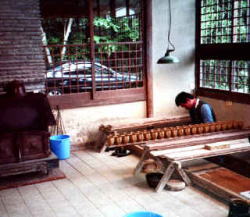 who is famous throughout the world. I knew
that Japan rightfully honors it's artisans
with a status that is rare in other countries,
and I was eager to see his work. In fact,
we were both continually drawn to the many
regional arts and crafts of Japan that are
admired around the world. Until now I have
not mentioned my passion for Japanese pottery.
I was told early in our trip to wait until
we arrived in Karatsu to purchase pottery
as it is an area with many fine pottery styles,
or do I say "Yaki"? It is all very
beautiful as well as very expensive, so choosing
is difficult. Next we visit a building where
14 giant sized floats are carefully stored,
in anticipation of the local Okunchi or Harvest
festival which is who is famous throughout the world. I knew
that Japan rightfully honors it's artisans
with a status that is rare in other countries,
and I was eager to see his work. In fact,
we were both continually drawn to the many
regional arts and crafts of Japan that are
admired around the world. Until now I have
not mentioned my passion for Japanese pottery.
I was told early in our trip to wait until
we arrived in Karatsu to purchase pottery
as it is an area with many fine pottery styles,
or do I say "Yaki"? It is all very
beautiful as well as very expensive, so choosing
is difficult. Next we visit a building where
14 giant sized floats are carefully stored,
in anticipation of the local Okunchi or Harvest
festival which is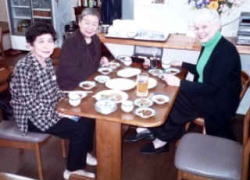 held in Karatsu each November. After
lunch we are guests at a tea ceremony, which
is truly an art form. Later our host, who
has also trained in traditional dance, performs
for us. An added treat! held in Karatsu each November. After
lunch we are guests at a tea ceremony, which
is truly an art form. Later our host, who
has also trained in traditional dance, performs
for us. An added treat! Throughout our stay at Yoyokaku, Harumi-san and Den-san planned many wonderful excursions and joined us as often as their busy days allowed. Before we departed Yoyokaku we attended another tea ceremony as the guest of Harumi-san, giving us another delightful experience to remember. Later that day we had the honor of visiting the home of a most gracious lady, Haruko Ichimaru, with whom we have developed a wonderful friendship. All too soon we must leave our friends and Yoyokaku, our Japanese home. We have one more stop in Sasebo, before returning to Virginia. Yoyokaku remains my finest memory of Japan. It isn't just this gracious old inn with its quiet dignity, good food, and fine service, or it's garden of ancient trees. Rather it is the bond of friendship between two families that crosses many borders and continues to warm our hearts. |
|||||||||||
|
|||||||||||
The Miracle Sword -Part Ⅱ Written by Thomas H. Sugg Thank you very much for visiting this page. I hope you will return next month. Yours, Harumi Okochi Proprietress of Ryokan Yoyokaku |
|||||||||||
|
|
|||||||||||